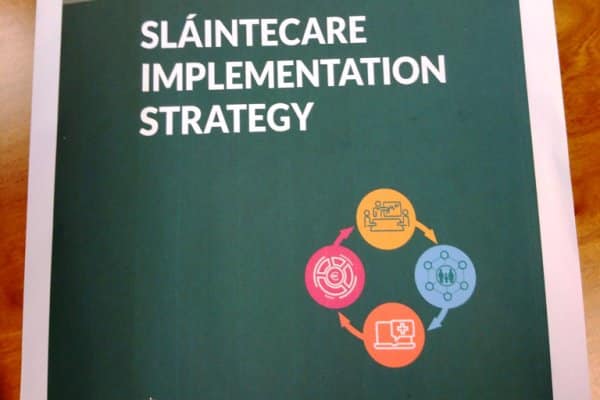
![]()
The Health Minister has defended the government's record on hospital waiting lists. Simon Harris launched the new Sláintecare Implementation Plan this morning saying it will be a guideline for the future of the health service.
An all-party Oireachtas committee launched the 10-year Sláintecare plan for the health service last year. It includes commitments to reduce hospital waiting times, increase bed capacity and to try to disconnect public and private healthcare.
But there's no detail yet on how the plan will be funded. While Fianna Fáil attempted to rain on the government's parade this morning, releasing figures that show there's almost 1 million people on hospital waiting lists.
The 10 year plan has been devised to be above politics with hopes it will survive even if the government falls. Though many would rather see progress on waiting lists now, than looking off into the future.
Taoiseach Leo Varadkar said:
“We know that our health and social care services as currently designed cannot meet the growing demands being placed on them.
"Our population is changing rapidly, bringing with it changing healthcare needs. There is an overwhelming consensus that a transformation is needed in the way we deliver care and that this must be planned, managed and delivered within a coherent system-wide reform programme.”
The key actions for the first three years of reform include:
******
The Health Reform Alliance called it “an important step on the road to universal healthcare in Ireland”. However, it has highlighted the absence of costings in the strategy and called for a commitment for multi-annual funding to be made from Budget 2019 on.
Acquired Brain Injury Ireland also welcomed the new Slaintecare strategy which confirms that implementation of the neurorehabilitation strategy will begin in 2018.
With 13,000 new brain injuries acquired in Ireland every year, timely access to neuro-rehabilitation is crucial at all stages.
The Irish Nurses and Midwives Organisation responded to Sláintecare and are awaiting an early meeting with the Minister for Health and the Sláintecare office.
The INMO wants to see a focus on solving the recruitment and retention problems in nursing and midwifery, and to help develop nursing and midwifery-led services.
INMO General Secretary Phil Ní Sheaghdha said:
“We have always been strong advocates for Sláintecare and want to see the report implemented in full. More information is needed on the government’s plans than was delivered today, and we have sought an early meeting with government.
“But the real challenge for Sláintecare is funding. There are already hundreds of nursing and midwifery vacancies across the country, which the HSE simply can’t fill.
“Unless the government focuses on solving the recruitment and retention crisis in nursing and midwifery, the expanded services in Sláintecare simply won’t become a reality. Nurses’ and midwives’ inadequate pay has to be addressed.
“And while ministers are right to allocate extra capital spending for the health service, that will be money down the drain unless new facilities are properly staffed.”
#Sláintecare is a vision for the future our Health Service.
Making changes that are necessary to benefit the Irish people will require a 10 year commitment across Government, the political system, the health service and the public.
Full report: https://t.co/nzfAcZHY28 pic.twitter.com/8jbBdNZ8M9
— Department of Health (@roinnslainte) August 8, 2018
The #slaintecare strategy sets out a clear roadmap for much needed reform of the health service-we are fully committed to supporting Government in their plan for health reform," @profmaryhorgan https://t.co/Z3tJwXqxV2 @SimonHarrisTD @RoisinShortall pic.twitter.com/WrttgBD3la
— Royal College of Physicians of Ireland (@RCPI_news) August 8, 2018